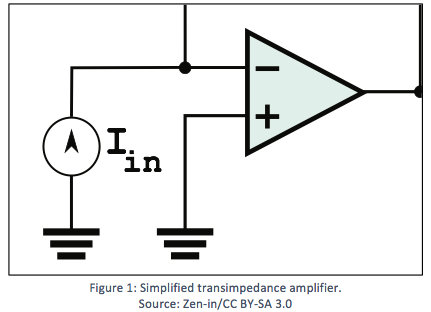
The Ins and Outs of Transimpedance Amplifiers

At its most basic level, an optical communication system uses a transmitter to encode a message into an optical signal; a channel, to carry that signal to a destination; and a receiver, to turn the signal back into its original, readable form.
A key component at the receiving end of the system is a device that can convert light energy into an electric signal. That device —known as a photodiode or photodetector —is designed to allow current to pass through in the presence of light, and to stop current from passing through in the absence of light. To turn that current into a usable signal, a common electrical circuit configuration is employed: a transimpedance amplifier, or TIA.
The TIA configuration typically includes an operational amplifier (op-amp), one of the most widely-used devices in electronics design. An op-amp is capable of tremendous gain: It can take a tiny input signal and transform it into a greatly magnified output signal. Because the op-amp’s gain is so extreme, a feedback resistor is built into the configuration. This configuration, as shown in the diagram at right, effectively converts a low-level photodiode current signal into usable voltage output —current in, voltage out.
Theoretically speaking, that’s TIA in a nutshell. Yet in practice, there are challenges to building stability into the system. One standard approach is to add a feedback capacitor across the feedback resistor in order to address the potential for oscillation. It’s an effective strategy, yet the tight interactivity between system elements means that changes to one can have a significant impact on all of the others. This translates into the need for decision-making regarding which trade-offs are acceptable within circuit optimization —examples include the desired gain, the level of bandwidth to be achieved and the amount of noise that can be tolerated.
Moreover, since the typical photodiode signal is very small, there may be multiple transimpedance stages within the system to optimize the balance between noise and bandwidth. If the first TIA stage results in too high a gain, attainable bandwidth will be limited. If the gain is too low, signal-to-noise ratio (SNR) will be degraded.
It’s worthwhile to note that TIAs are used in a wide number of applications beyond optical communication. Simply put, they are essential building blocks in any system that measures light: compact disc players, night-vision equipment, infrared remote controls and many more. Through a greater understanding of TIA principles and experience addressing TIA challenges, network designers can bring versatility to a broad range of tasks.






